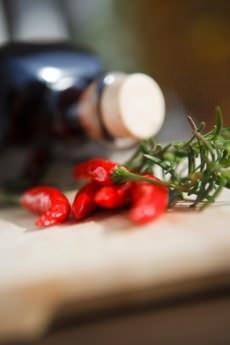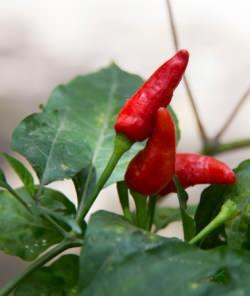Cultivating chili
Post from EditorialsThe chili is a very common plant on our tables and is easy to grow; here is some information on how to do and how to use it better.
Origins of chilli
 The chilli plant is really ancient: there are several varieties, the chili pepper that is commonly used in cooking, the ornamental chili, and even sweet peppers.
The chilli plant is really ancient: there are several varieties, the chili pepper that is commonly used in cooking, the ornamental chili, and even sweet peppers.
The original plant is part of the nightshade family, its Latin name Capsicum, according to some ancient beliefs, invokes the word capsa, or box, so the chili is viewed as a box, a container of various and irregular shapes that contains seeds.
This meaning, however, change if we seek the origins of its name in the greek world, in fact many associate it with the Greek word that means instead kapto, to bite, that clearly refers to the effect that this vegetable has when eating it or its spicy feeling.
Features of the chilli
This kind of plant, which named capsicum annuum is a short-life perennial shrub that, under conditions of unfavorable climate, is grown as an annual.
The plants of pepper have the shape of a bush that can reach heights ranging from 40 to 80 cm, depending on the type we are considering, the color of the leaves is generally of a light green. The flowers of the chili plant are distinctive for their white corolla, which has pale yellow stamens.
In order to eat the fruits of the chilli plant, they should be used immediately after their harvest, so as not to lose their property, but if you want you can also preserve in oil or powder them after dryingthem in the sun. This that we have just described, is the is the most common and widespread species, the classic table chili.
But there are other species that have completely different characteristics, such as the capsicum frutescens as Tabasco, which has a form of a shrub, or capsicum chinense or habanero that can be up to 2 meters in height.
How to grow chili
We mentioned earlier that the best time for sowing of chilli plant is from February to March, but it all depends on the climate, the optimal conditions would be in an environment at a temperature of about 25-30°C. In some varieties the germination times can be very long, but if you run a proper fertilization and a temperature of the compost of 30-35°C during the day, and of about 20°C at night, these can be reduced. The soil in which the plants have to be replanted after the first round of the leaves must be loose, acid, well-drained soil with a good component of sandy soil not too fertilized. During its growing phase, the chili needs a lot of water. A little trick to increase the spicy flavor of the fruit, is to reduce watering, sometimes excluding it, but only during the 48-72 hours prior to collection. Or you can water the plant when the leaves are down, this is a clear indication of lack of water.
The soil in which the plants have to be replanted after the first round of the leaves must be loose, acid, well-drained soil with a good component of sandy soil not too fertilized. During its growing phase, the chili needs a lot of water. A little trick to increase the spicy flavor of the fruit, is to reduce watering, sometimes excluding it, but only during the 48-72 hours prior to collection. Or you can water the plant when the leaves are down, this is a clear indication of lack of water.
The reproduction of this plant is generally by seed. This can also be done by cuttings the branches that are semi-mature, long 10 - 15 cm.
Usually this technique is used when we need to rejuvenate a chilli plant that was previously done overwinter indoors or in a greenhouse.
Most common species of domestic chili peppers and their pungency
Wanting to make a classification of the most common species of chili, surely we have: Capsicum annuum, which is the most widely grown, this species includes sweet peppers, the chili pepper common in Italy, the cayenne pepper, and the Mexican jalapeño. Then we have the Capsicum baccatum, which includes the so-called bishop's hat, and ajì. Capsicum chinense, which includes the habanero, which is considered as the hottest chilli pepper in the world. Then there is the Capsicum frutescens, which includes among others the Tabasco. And finally the Capsicum pubescens, which includes the South American rocoto. As we all know the chili is known just for its spiciness, this varies from species to species and there are many parameters that determine it. The substance principal architect of spiciness is the alkaloid capsaicin, which together with 4 other related natural substances called capsaicinoids, contributes to give different pungencies to the pepper.
As we all know the chili is known just for its spiciness, this varies from species to species and there are many parameters that determine it. The substance principal architect of spiciness is the alkaloid capsaicin, which together with 4 other related natural substances called capsaicinoids, contributes to give different pungencies to the pepper.
Each capsacinoide has its pungency and gives a different flavor in the mouth, a change in the proportions of these substances determines the different sensations produced by different varieties, as well as to their content.
The hotness of the chillies is measured empirically by the Scoville scale, in degrees from 0 to 10, and quantitatively in Scoville units, based in ppm weight/ weight of capsaicin.
When you overdo with the use of chili one of the best ways to relieve the burning sensation is to drink milk, eat yogurt or any dairy product, preferably a soft paste or liquid. In addition, capsaicin dissolves very well in fats and alcohol, so even fat products or alcoholic beverages help to remove the painful sensation. For high concentrations, as in habanero Red Savina or other extracts, the most effective way is to use ice as an anesthetic.
Uses of chili and its properties
 The chilli sauce is very popular, despite of the pain and the irritation it causes, the chili has an antibacterial effect, in fact the food cooked with hot peppers can be kept relatively long. The peppers are rich in vitamin C and are believed to have many beneficial effects on human health, as long as used in moderation. In addition, this fruit has a strong antioxidant effect, that has earned it the reputation of antitumoral activity. The chili has also proved useful in the treatment of colds such as colds, sinusitis and bronchitis and helps digestion. Other beneficial effects of chili peppers, is its aphrodisiac power,which have not been confirmed by scientific research. Many traditional folk medicines used chilli as a remedy, and in the Ayurvedic medicine it is recommended for the treatment of certain diseases such as peptic ulcers.
The chilli sauce is very popular, despite of the pain and the irritation it causes, the chili has an antibacterial effect, in fact the food cooked with hot peppers can be kept relatively long. The peppers are rich in vitamin C and are believed to have many beneficial effects on human health, as long as used in moderation. In addition, this fruit has a strong antioxidant effect, that has earned it the reputation of antitumoral activity. The chili has also proved useful in the treatment of colds such as colds, sinusitis and bronchitis and helps digestion. Other beneficial effects of chili peppers, is its aphrodisiac power,which have not been confirmed by scientific research. Many traditional folk medicines used chilli as a remedy, and in the Ayurvedic medicine it is recommended for the treatment of certain diseases such as peptic ulcers.
79163 REGISTERED USERS










